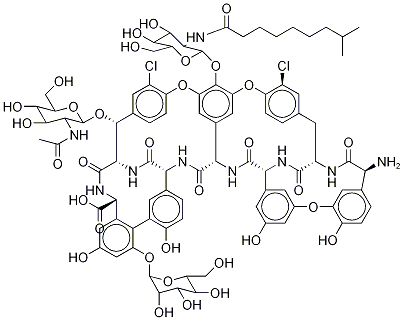Teicoplanin A2-2 is a useful compound to analyze the effect of hydrophobic substituents in the biological activity of glycopeptide antibiotics. It has also been used to synthesize teicoplanin derivatives that may overcome antibiotic resistance.
Glycopeptide antibiotic complex produced by Actinoplanes teichomyceticus; structurally related to vancomycin. Comprised of 5 major components differentiated by a specific fatty acid moiety. Inhibits peptidoglycan synthesis in the cell wall of gram-positive bacteria.
Teicoplanin A2-2 is a major analogue of a family of lipoglycopeptides produced by Actinoplanes teichomyceticus which possesses potent broad spectrum antibiotic activity against Gram positive bacteria, including MRSA and E. faecalis.
ChEBI: A teicoplanin A2 that has 8-methylnonanoyl as the variable N-acyl group.
teicoplanin a2-2 is a new glycopeptide antibiotic belonging to the same family as vancomycin. teicoplanin consists of five major components (a2-1 through a2-5), one hydrolysis component (a3-1), and four minor components (rs-1 through rs-4) [1]. teicoplanin is isolated from the fermentation broth of actinoplanes teichomyceticus nov. sp. and has been endowed with outstanding bactericidal activity against grampositive pathogenic bacteria [2].[1] bernareggi a, borghi a, borgonovi m, et al. teicoplanin metabolism in humans[j]. antimicrobial agents and chemotherapy, 1992, 36(8): 1744-1749.[2] s. somma, l. gastaldo and a. corti. teicoplanin, a new antibiotic from actinoplanes teichomyceticus nov. sp. antimicrobial agents and chemotherapy 26(6), 917-923 (1984).[3] rowland m. clinical pharmacokinetics of teicoplanin[j]. clinical pharmacokinetics, 1990, 18(3): 184-209.
teicoplanin inhibited cell wall synthesis in bacillus subtilis, the inhibition is accompanied by an intracellular accumulation of udp-n-acetyl-muramyl-pentapeptide. in a cell-free system from bacillus stearothermophilus, treatment with teicoplanin (40 μg/ml) inhibited 50% of peptidoglycan synthesis, and 100 μg/ml teicoplanin totally suppressed peptidoglycan synthesis [2].
following intravenous administration, concentrations of teicoplanin were high in lung and bone tissue and low in fat in relative to those in plasma in patients with normal renal function. animal data showed high concentrations in most tissues, and particularly high in liver and kidneys [3].
